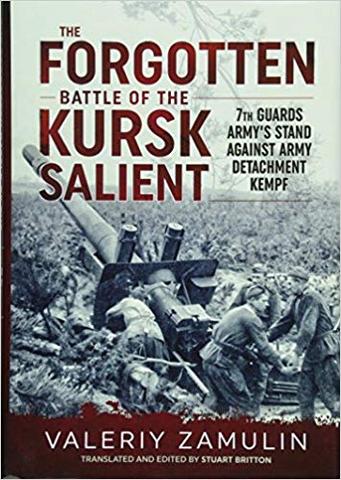The Forgotten Battle of the Kursk Salient

The Forgotten Battle of the Kursk Salient is the third English language translation of Valeriy Zamulin's near incomparable break-down and analysis of The Battle of Kursk. I have previously reviewed his two earlier works covering other aspects of this, one of the most important battles of the Second World War. I find this latest effort as ranking among his finest work.
In this volume Zamulin once again returns to the efforts made by the Red Army's Voronezh and Steppe Fronts in defeating Germany's Army Group South’s quest to meet the goals set for Operation Citadel (the German code name for their offensive). Just to remind readers who may not be acquainted with the author he is a former Deputy Director and Director of Research at the Prokhorovka Battlefield Park Museum. Moreover, he is as thorough a researcher as they come who not only has mined important archival records, but writes from the unique position offered by having spent the bulk of his life where these events took place.
In this companion volume to his earlier work focusing on the II SS Panzer Corps part in Citadel, culminating in its epic clash with the 5th Guards Tank Army at Prokhorovka, The Forgotten Battle of the Kursk Salient covers Army Detachment Kempf's efforts to break through the 7th Guards Army's defensive front. Located just east of the Fourth Panzer Army (of which the II SS Panzer Corps formed a key part), Army Detachment Kempf was spearheaded by the III Panzer Corps. It's most important goal was to overcome the Soviet 7th Guards Army's extensive defensive front as well as the numerous geographic obstacles in its area of operations. From there, it was to link up with the Fourth Panzer Army to its west and form a massive joint armored spearhead capable of doing immense damage to Soviet prospects for conducting a summer campaign.
Meanwhile, the Soviet 7th Guards Army was a crucial component of Voronezh Front Commander-in-Chief General of the Army N.F. Vatutin's defensive effort. To that end Vatutin assigned the 7th Guards Army two very important tasks. First, force Army Detachment Kempf into a slow slugging attritional battle bogged down within the 7th Guards Army's deeply echeloned defensive front. Second, in holding its position help create the conditions for a Soviet counter-offensive aimed at once more retaking Kharkov and advancing west deep into the Ukraine. To this end it was imperative that the 7th Guards Army prevent Army Detachment Kempf's forces (led by the 6th, 7th, and 19th Panzer Divisions in the III Panzer Corps) from linking up with the German Fourth Panzer Army and thus in failing to allow the Germans to combine two of Army Group South's three great armored spearheads thus deny the German forces the abilty to break free of the Soviet defensive front, threaten the existence of the Voronezh Front, and defeat the Red Army's strategic reserve (the Steppe Front).
As explained by the author, the importance of the 7th Guards Army's goals could not be understated. Though the events that would occur on the Prokhorovka axis of combat to this day dominates the attention of most students of the Kursk campaign, Zamulin makes a compelling case as to why had the 7th Guards Army failed in its goals that Germany's Army Group South may have pushed the Red Army back on its heels and thereby granted the German command the breathing space it sought. In addition, Zamulin also covers the Soviet 69th Army's role in assisting the 7th Guards Army's efforts, but ultimately why it was the 7th Guards Army that played an underappreciated and key role in guaranteeing the failure of Army Group South's portion of Operation Citadel.
The Forgotten Battle of the Kursk Salient is broken down into nine chapters covering the vast bulk of the book's 648 pages (with footnotes chosen instead of endnotes to document the author's sources). I loved this book, but I must warn the reader that it is not for the casual World War II enthusiast. Each chapter is huge and densely packed with an incredible amount of information as well as cogent and welcome analysis. There are entire chapters spanning as much as one hundred pages and yet so granular as to be focused on events from a single day. Now, if like me, you are obsessed with the fighting in and around the Kursk salient during the first two weeks of July 1943 and the prep work each side engaged in on this part of the front leading up to the battle then I can guarantee that you as well should equally enjoy the fruit of Zamulin's incredible efforts. Though I wish there could have been just a few more maps, those that are included certainly are well-done as are the numerous tables that help to make sense of the composition and losses of the respective armies involved. In short, I highly recommend this book and fervently hope to see more in the near future from Mr. Zamulin.



Post new comment